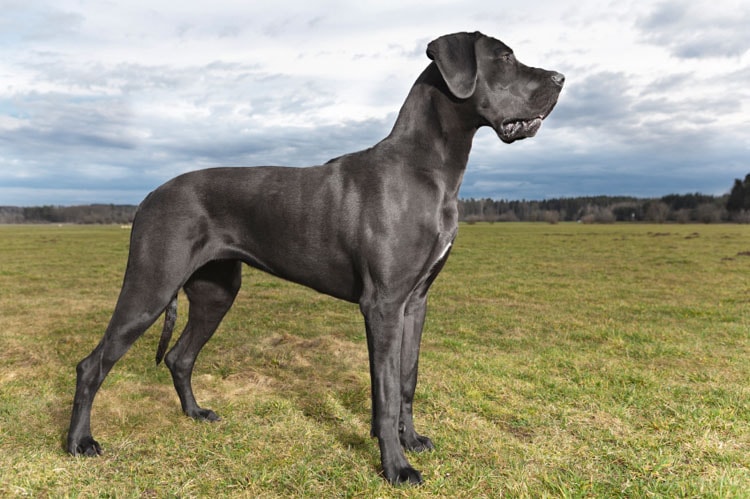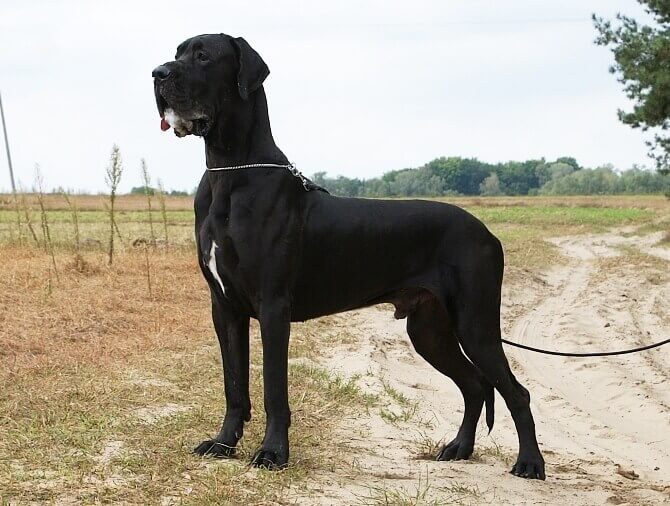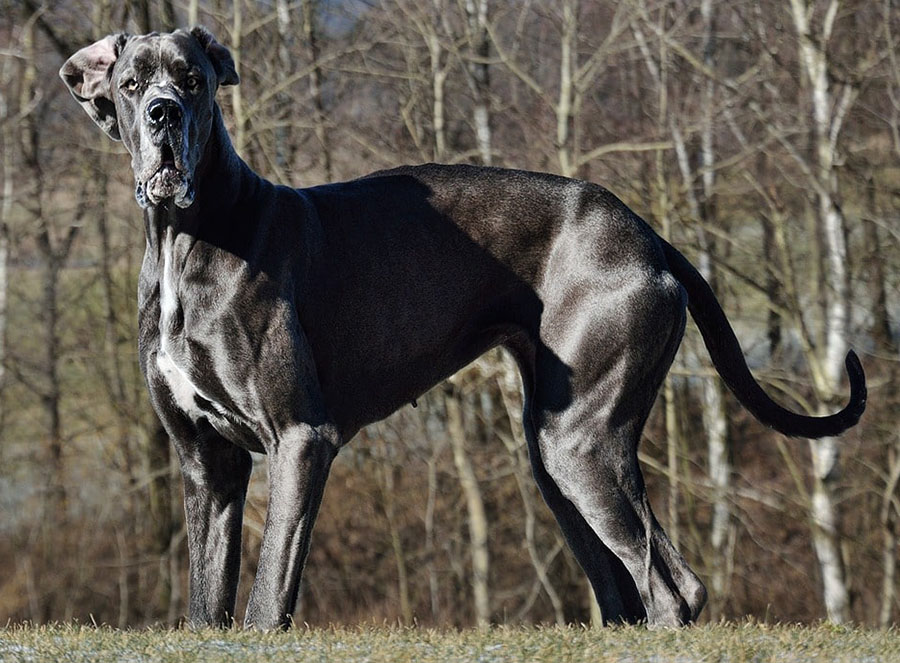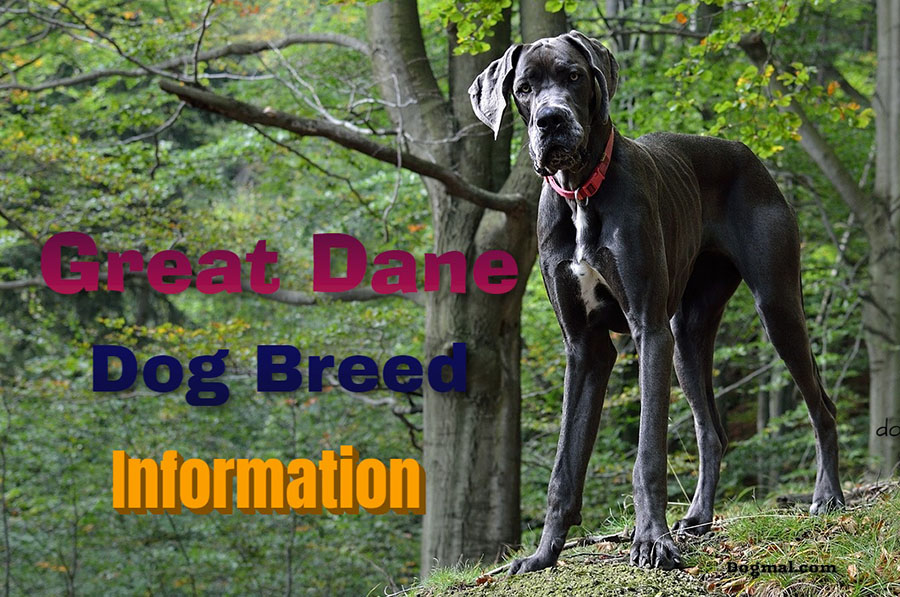Great Danes are mastiff-type dogs. The Great Dane is a pleasant, people-oriented dog that is easy to housetrain and responds well to positive reinforcement training. It makes a good house dog. They enjoy playing with kids and are kind to them.
Are you thinking of bringing a Great Dane puppy into your family? Or are you looking for Great Dane information or wanting to know? In this article, we have put together all of the important information about this house dog. So read the article carefully and enjoy with your lovely Great Dane.
Content Overview:
- History
- Different names
- Appearance and Characteristics
- Personality and Temperament
- Health & problems
- How to take care
- Puppy Information
- Puppy price
- Things to consider adopting a puppy
- Advantages & Disadvantages
- Great dane pictures
History
Great Danes are a breed of dog that originated in Germany and has been around for over 400 years. They are robust and massive dogs bred from an English Mastiff and an Irish Wolfhound. Great Danes were originally bred for hunting, specifically for boar hunting. Although, because they were large dogs, they were also used to guard country estates.
Over time, the breed lost its reputation as a hunting dog and gained a reputation as a watchdog and friend. German breeders tried to make them less aggressive, which resulted in the calm temperaments that are so popular today. The name “Great Dane” was prohibited in Germany in 1880, and the breed was renamed “Deutsche Dogge,” which means German mastiff.
Great Danes first debuted in the United States in the late 1800s and have gradually grown in popularity since then. The American Kennel Club officially recognised the breed in 1887.
Different Names
Other’s Name:
- Deutsche Dogge
- German Mastiff
- German Boarhound
Popular names:
- Apollo of dogs
- Gentle Giant
Appearance and Characteristics
Body: The Great Dane has a long and robust body.
Head: It has a huge, thin, and flat-topped head.
Ears: Its ears are droopy. The ears are clipped to stand straight or droop forward.
Eyes: It has a pair of deep-set eyes. Except in harlequins and merles, where blue or other hues are available, their eyes are almond-shaped and black.
Eyebrows: The eyebrows are well-defined.
Nose: A Great Dane’s nose is normally black in colour. Blue Great Dane noses have dark blue.
Neck: The neck is strong and long.
Muzzle: The muzzle is broad and deep in general.
Legs: The legs are straight.
Tails: The tail is medium in length. It’s thick at the top and thins off as it gets closer to the hocks.
Coat & colors: The coat is short and sleek. The coats of Great Danes require less care and are light-to-moderate shedders. Brindle or fawn, blue, black, or harlequin, which has black patches over a white backdrop, are some of the colours available.
Characteristics
Height
Male: 30 to 34 inches tall
Females: 28 to 32 inches tall
Weight
Male: 120 to 200 pounds.
Females: 100 to 130 pounds.
Country of Origin: Germany
Life Span: 6 to 8 years
Family: Mastiff-type family
Type: Hunting boars, guardian
Trainability: Very easy to train
Friendliness: Good
Exercise Needs: Minimum
Energy Level: Average
Grooming: Low to moderate
Barking: High
Protective Ability: High
Hypoallergenic Breed: No
Space Requirements: House with Yard
Compatibility With Other Pets: Good
Tendency to Drool: High Tendency to Snore
Bark level: Low
Tendency to Dig: Low Social
Attention Needs: High
Personality and Temperament
This dog breed is social, friendly, and just delightful. The Great Dane is a calm and affectionate animal. Proper care and training make them wonderful companions for kids.
Activity requirements
This breed is lively, intelligent, and enjoys being active. They are quick learners, so training will be fun and productive for them. A great dane may become scared or aggressive towards new stimuli, including strangers and new situations, if not properly socialised. Early socialising is essential for Great Danes.
With family & kids
The Great Dane desires to be with his family. They enjoy being near people and other animals. They enjoy meeting new people, even strangers and children, and will gladly welcome visitors unless they believe you need to be defended. Great danes are relaxed with children. Regularly inviting visitors around, as well as taking your dog to crowded parks, dog-friendly stores, and leisurely taking a stroll to meet neighbours, will help them improve their social skills.
Health & problems
Great Danes are a generally healthy breed. They are, unfortunately, vulnerable to specific health issues. Sometime they inherite some health problems by their parents. Although not all Danes will contract any or all of these illnesses, it’s vital to be aware of them if you’re thinking about getting one. It is important that you have completed their vaccinations on a regular basis.
Adopting an adult dog from a shelter or rescue organisation. Some health issues aren’t apparent in puppyhood, but by getting an adult dog, you can rule out the majority of them. As a result, seeing your veterinarian every six months is important. Your veterinarian will work with you to construct a preventive strategy to help you avoid a variety of health issues.
Always purchase a puppy from a well-known breeder. A good breeder will tell you that the breed has no known health issues and is completely healthy. Do not buy a puppy from a breeder who cannot give you documented proof that the parents have been cleared of any breed-related health issues.
Great dane may suffer from the following health problems
- Wobbler syndrome
- Skin irritation
- Cardiomyopathy
- Hip Dysplasia
- Osteosarcoma
- Cataracts
- Bloat
How to take care Great Dane
Feeding Plan:
One of the most important tasks for their health is to provide them with food. Because a Great Dane’s first years of life are marked by rapid growth, correct nutrition is crucial to their long-term health and longevity. Always follow your veterinarian’s instructions when it comes to feeding your dog.
Knuckling over, crooked legs, Hypertrophic Osteodystrophy, and Osteochondritis Dissecans are all symptoms of overfeeding.
Feeding chart:
|
Puppy Age |
Cups per day |
|
2 Month |
2 – 4 cups three times per day |
|
3 Month |
3 – 5 cups three times per day |
|
4 Month |
4 – 6 cups three times per day |
|
5 Month |
5 – 7 cups twice a day |
|
6 Month |
6 – 8 cups twice a day |
|
7 Month |
6 – 9 cups twice a day |
|
8 Month |
6 – 9 cups twice a day |
|
9 Month |
7 – 10 cups twice a day |
|
10 – 12 Month |
7 – 10 cups twice a day |
|
12 – 18 Month (females) |
6 – 9 cups twice a day |
|
12 – 18 Month (males) |
7 – 10 cups twice a day |
Water requirement
The amount of water your dog drinks will affect the quantity of food he consumes. Your Great Dane should have unrestricted access to clean, fresh water at all times. He’ll be less likely to eat you out of the house or home if he drinks a much. Of course, this does not imply that you should force him to drink only water. It simply means he won’t need to eat as much because the water will keep him strong and sustained.
Exercise needs
Great Danes are energetic, playful dogs who require a lot of activity to stay fit and healthy. They require a lot of outside room for exercise because they are the largest breed of dog. To burn off their excess energy and stay in condition, Great Danes require at least two hours of exercise per day.
Rather than attempting to complete two hours in one session, we recommend spacing it out over the course of the day. It could be a mix of walking and off-leash exercise in a safe environment. In addition, your Great Dane will want plenty of free time in a large garden, as well as training sessions to keep them entertained.
When exercising a Great Dane puppy, be cautious because too much exercise too soon will impair their bone and joint development. Excessive exercise can harm their joints.
Grooming Needs
Great Danes are low-maintenance when it comes to grooming because of their short coats. They do, in fact, shed. Your Great Dane may shed more in the spring and autumn, requiring extra attention. On the skin, in the nose, mouth, and eyes, and on the feet, look for sores, rashes, or symptoms of infection such as redness, tenderness, or inflammation.
Brushing: Remove any loose hair with a soft bristle brush. Brush in the direction in which the coat grows. It is more relaxing for your dog. Although Great Danes are not prone to matting, any mats should be gently untangled using your fingers or a comb. Do not brush through matted hair.
Bathing: This sensitive dog can be bathed weekly or every six to eight weeks, depending on his activity level and lifestyle. This smooth-coated breed requires bathing to reduce shedding and maintain healthy skin and hair.
Teeth cleaning: Brush your Great Dane’s teeth at least twice or three times a week to get rid of tartar and the bacteria that thrive inside it.
Ear cleaning: They should have their ears checked once a week for redness or a foul odour, which could suggest an infection. To help avoid infections, wipe out your dog’s ears with a cotton ball wet with a moderate, pH-balanced ear cleanser. Do not clean the ear canal; instead, clean the outside of the ear.
Nail trimming: Once or twice a month, trim their nails.
Puppy Information
If you trained a Great Dane from a young age, they would be sweet and placid dogs and often quite easy to train. A Dane is a quick learner when it comes to housetraining and is extremely loving and obedient. Only calm and pleasant training methods should be used while training a Great Dane.
Aggressive or severe punishment should never be used. The Great Dane is a highly sensitive breed that quickly picks up on the emotions and approval or disapproval of its handlers and owners. When outside, the Great Dane should be on a leash or lead and kept in a gated yard or on a leash.
Puppy training:
They are desirous to please, intelligent and calm-natured. Great Dane puppies are comparatively simple to coach. They need smart attention. They need an experienced trainer to teach. Begin to coach once your puppy become eight weeks old.
Female Great Danes are comparatively simple to coach. They’re naturally not aggressive and dominant as compare to males. You must never spoil your puppy or permit any unwanted behaviors like jumping on the couch, biting your shoes.
Socialize: Socializing this breed will prepare them for strange things. Socialize can create your dog a stable, pleasant and fearless adult. This can reduce their shyness and forestall developed aggression towards strangers, ‘other dogs, and fellow animals.
The Great Dane puppy will learn basic commands, like “sit”, “stay”, “down”, or “heel”. This is the simplest way to discipline a Great Dane puppy or adult is by leading them confidently and quality.
Bite: It’s solely natural for puppies to bite. If your pet begins biting as you play with them, quickly and severely tell them “no”. Please provide them with any soft toys for chewing. This can stop your puppy biting habit.
Barking: Barking could be a dangerous habit. If your pup bark at the unknown, then never instantly attend to them. Allow them to recognize you’re not reward them for barking. Once they need to be calmed down, then you’ll be able to go to them.
Potty Training: Potty training is very important for them. You also ought to perpetually take puppies resolute go potty. Allow them to move into a washroom after a meal, drinking water, a nap, playtime.
Puppy price
The great dane puppy price is between $800 up to $3,000.
Things to consider adopting a puppy
Knows Facts Related to great danes
Yes, great danes are sweet and cuddly, but they are massive. If you enjoy large dogs, a Great Dane is an excellent choice.
You’ll need money for his food, snacks, toys, bedding, collar, and veterinarian visits, among other things. As a result, be certain you’re financially prepared.
It should come as no surprise that they were bred to hunt. They are big and powerful. They are also fiercely loyal to their owners. It is an excellent guard dog.
They’re huge. As a result, they are still immature when they are young. This means that this large dog will be bouncing or jumping around your house. As a result, puppy training is very important.
You must pay close attention to their diet. This means they’ll need plenty of nutritious, high-quality food to help them grow.
While you may believe that your Great Dane simply requires a lot of space due to their size, this is not always the truth case. In fact, these dogs do need space to run and play.
It’s important that you spend quality time with them. They also require their family members to spend quality time with them and play with them.
Choose a Right Breeder:
Adopting or buying a Great dane puppy is a big responsibility. Finding the right breeder is the best way to find the right dog. Ask your veterinarian which breeder is best for adopting a puppy. You should also be able to find the right breeder via the website.
A reputable breeder will match you with the ideal puppy. A good breeder will reply to your questions. Choose a breeder who is not just willing but eager to assist you in training and caring for your new dog.
Avoid breeders who just seem interested in selling puppies as rapidly as possible. Breeders who sell puppies “with papers” for one price and “without papers” for a lesser price. If you buy a make sure it comes with all of the necessary paperwork.
A professional breeder will be honest and open about the breed’s health issues and the frequency with which they arise in her lines.
A Right breeder who tells you that the breed has no known problems and it is 100 percent healthy.
Make sure your breeder understand your rights and recourses.
Do not buy a puppy from a breeder who cannot give you documented proof that the parents have been cleared of any breed-related health issues. A “vet checked” certificate is not a substitute for genetic health testing.
Don’t ever purchase a puppy from a pet store. At a pet store, you’re more likely to get an unhealthy, sick, unsocialized, and difficult to housetrain puppy and will be supporting the cruelty of high-volume puppy mills.
Advantages & Disadvantages
Advantages:
- Protective to their owners.
- It can make a good watchdog
- Easy to grooming
- Make good companion pets for active families
- Good with kids.
Disadvantages:
- This breed requires training from an early age.
- These dogs are difficult to manage once they reach full size.
- It is not suitable for apartment living.
- This large sized dog needs a home with a fenced yard.
- It has less life span in comparison to other breeds
- Not good for first time dog owner.
Great dane Pictures

Image credit: mouss-le-chien.com


Got some questions? Or some suggestions? That’s why we’ve got a comments section on this blog! You can feel free to leave a comment or two down, below and we’ll get back to you as soon as possible!
We love reading your messages……
